印尼最吓人的美食
BBC西奥多拉·撒特克里夫(Theodora Sutcliffe)(2016年5月8日)
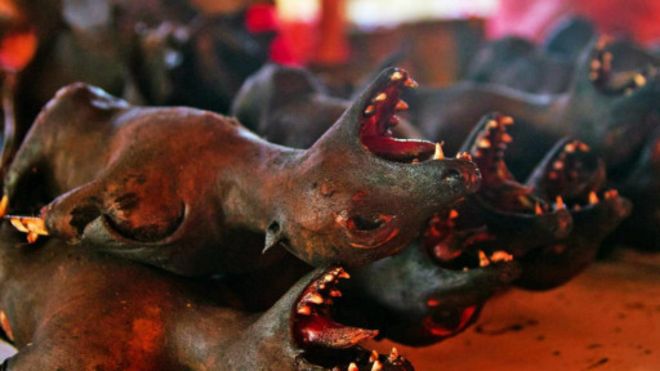
托莫洪市场(图片来源:Theodora Sutcliffe)
一只狗烧焦的尸体僵硬地躺在那儿——开着的口鼻高高向上,四脚朝天。在市场的另一端,一个屠夫肢解了另一条狗的尸体,砍掉了它的头,把身体切成大块出售。在放着那具尸体的桌子下方,一只猫偷偷地走过,喵喵地低泣着。其他还活着的狗都骨瘦如柴,好似失去了任何营养价值,蜷缩在那儿绝望地打着盹。
这是印度尼西亚最繁忙的托莫洪市场(Tomohon Market)内,米纳哈萨(Minahasa)肉类区的一个典型的星期六早晨。托莫洪市场位于北苏拉威西岛的火山高地。整齐截掉翅膀的蝙蝠张着嘴,露着牙,无声地叫着;一条大蟒蛇苍白的内脏从剖开的腹部暴露出来;老鼠一只只被棍子刺穿身体,像烤肉串一样堆在一起。空气中弥漫有一种淡淡的粪便气味挥之不去。穿着牛仔裤和T恤、运动短裤和仿冒的鳄鱼牌衣服以及上衣的顾客,看起来和印度尼西亚其他市场并无差别,但他们几乎全部是以奇特却又极其美味的食物而闻名米纳哈萨人。
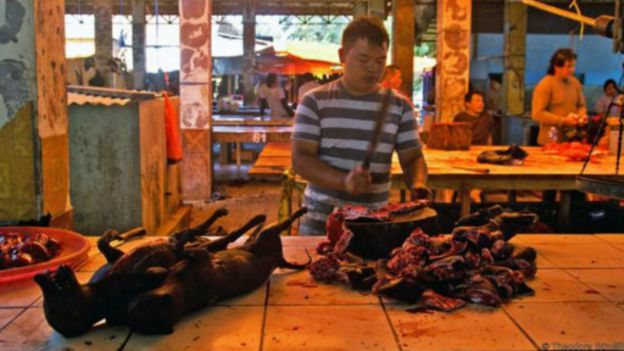
“在市场的另一端,一个屠夫肢解了另一条狗的尸体”(图片来源:Theodora Sutcliffe)
虽然米纳哈萨人在几世纪之前就离开了森林,但他们吃的肉类,有很多仍旧跟6000年前居住在高地上的祖先吃的一样,包括野熊、蛇和蝙蝠。“在复活节的时候,市场上还会有猴子和乌龟出售,”探索领队迈克尔·赖辛格(Michael Leitzinger)说,他经营着附近的一个高地度假别墅和水疗场所。“他们在请客款待别人的时候会吃这些东西,就像我们可能会在圣诞节的时候吃火鸡一样。”
如今的米纳哈萨人大部分都是基督教徒。19世纪的时候,荷兰的殖民政府取缔了米纳哈萨当地所有形式的祭祀仪式,包括割取首级献祭、多家庭混居以及石棺下葬等。清教传教士如此有效地推动了基督教信条的传播,以致于在1857年有1万的米纳哈萨人在一天之内改信了基督教。
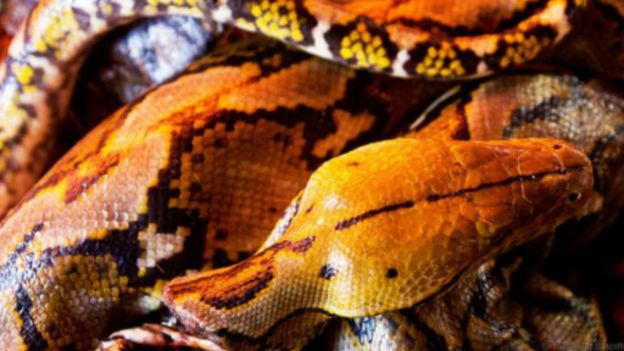
米纳哈萨人从他们的祖先那里继承 了食蛇的口味习惯。(图片来源:Theodora Sutcliffe)
虽然信仰上经历转变,但是历史上拥有法力的领袖,托那(Tonaa)的塑像在托莫洪镇上仍跟教堂一样普遍。在镇子外的Woloan区,香烟和被称作“老鼠牌”(cap tikus)的烈酒——这种酒是从棕榈树的树液中提炼出来的——被放置在一棵位于古老石棺废墟旁的圣树下,被当作用来献给居于这片土地上的古老神灵的供品。
位于索普坦火山(Soputan volcano)附近的斜坡上,有一块名为“Watu Pinawetengan”的神圣巨石,这里禁止使用血腥的魔法,很显然是因为巨石的看管者拒绝清洗遗留在上面的血渍。但是米纳哈萨黑魔法的法师仍在满月的时候在秘密的山洞里用动物来做祭祀品。
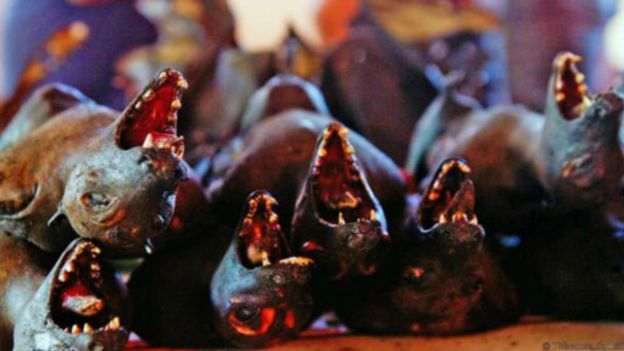
“蝙蝠张着嘴,露着牙,无声地叫着”(图片来源:Theodora Sutcliffe)
“白魔法一般会使用一只白鸡,但是在用其他种类的魔法时,白色或黑色都行,”当地一位法师维拉妮卡(Veronica)解释道。
维拉妮卡是一名天主教教徒,跟几乎所有的米纳哈萨人一样,用着一个基督教的名字,但是她不认为她的宗教信仰和魔法力量存在冲突。她相信圣人只是神灵的另一个名字。对于维拉尼卡而言,魔法和食用古老森林食物的习惯都是一种非同寻常的、具有持久力的文化的特征。“米纳哈萨文化就是一种生命力很强的文化,”她说。“无论这个世界已变得多么现代化,米纳哈萨人将会一直坚持古老的生活方式。”
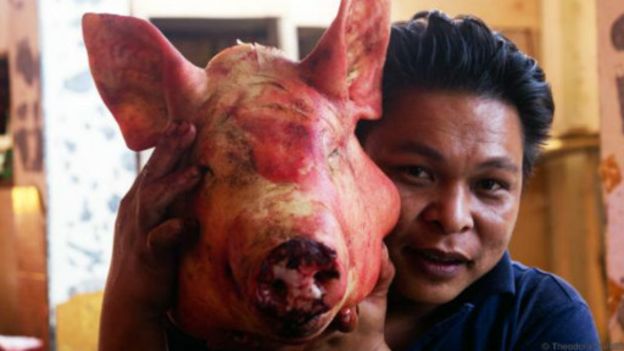
托莫洪市场在令人毛骨悚然的欢乐之下(图片来源:Theodora Sutcliffe)
的确,米纳哈撒人吃的东西有严格的规定。我的米纳哈萨导游亚当·邦高(Adam Pongoh)告诉我说:“我们不吃自己镇上的狗。”因此,那些在夜晚从其他镇上捉狗的人在印度尼西亚的其他地方受到了普遍的憎恨。
当邦高的父亲尤努斯(Junus)在35年前开始在托莫洪市场卖香料的时候,濒临灭绝的眼镜猴(一种小型的大眼灵长类动物)和斑袋貂(苏拉威西地区独有的一种夜间行动的有袋类动物)在当时仍在出售。之后政府打压了对这些动物的售卖行为,使得在今天要找到濒危动物非常之难。
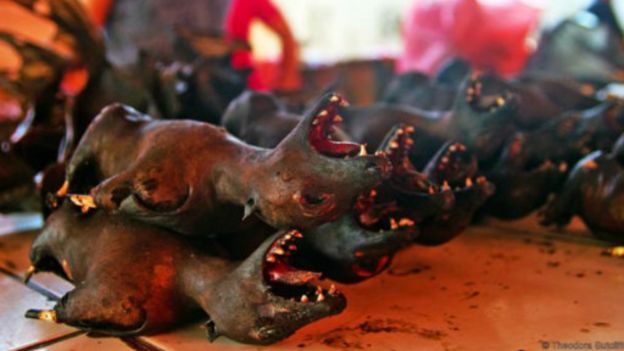
蝙蝠是托莫洪市场上出售的烹饪调x'料之一(图片来源:Theodora Sutcliffe)
托莫洪市场上绝大多数的奇特肉类都是买回家作为特别料理的美食,而不是餐厅的菜。邦高说蟒蛇肉正在变得越来越稀有:“它吃起来像鸡肉,我们使用料理鸡肉相同的辛香料,但是鸡肉的价格要便宜一半。”
我之前曾尝过狗肉,是用米纳哈萨当地的做法,加入南姜、辣椒、大蒜、红洋葱等料理的,味道非常美味,但是吃起来却很费劲(传统的米纳哈萨烹饪很少会考虑骨头的问题,我个人觉得,在吃的过程中我很难光用牙齿将狗肉从骨头上咬下来)。所以当邦高带我到本扎EG餐馆(位于托莫洪Kuranga村的JalanDosen),我得知狗肉早已卖完的时候心里大为释然。但是餐馆里当天还有蝙蝠肉,蝙蝠被剁成了小块,还带着油腻如胶的黑皮,看上去让人丝毫没有胃口。但是带有野味的肉与凤梨、椰子咖喱的结合创造出了一种神奇的美味。

托莫洪位于北苏拉威西岛的火山高地(图片来源:Theodora Sutcliffe)
之后上来的蟒蛇肉,用一种鲜美的rica-rica酱来烹制,加入大量的辣椒与柠檬罗勒。莽蛇肉吃起来味道不错——味道同鸡胸脯肉差不多——但是肉里有太多小刺,而带有花纹与油脂的蛇皮则是完全超越了我的忍受极限。
的确,米纳哈萨的食物因其不同寻常的食材而臭名昭著,但是米纳哈萨人通过一代代传下来的秘方制作的辛香料酱却给他们的食物带来了声誉。米纳哈萨所有的酱料都是从最基础的辛香料开始制作的,包括辣椒、盐、大蒜、姜、姜黄和石栗,这些调料要用一根特别长的杵捣碎。像美味的 babi daun leilem(一种用 leilem 叶子烹制的猪肉)就是从米纳哈萨地区独有的树叶中获得了它所拥有的独特风味。米纳哈萨地区的植物非常特别,托莫洪大学有一个草药医学部门专门研究这些植物的传统功效。
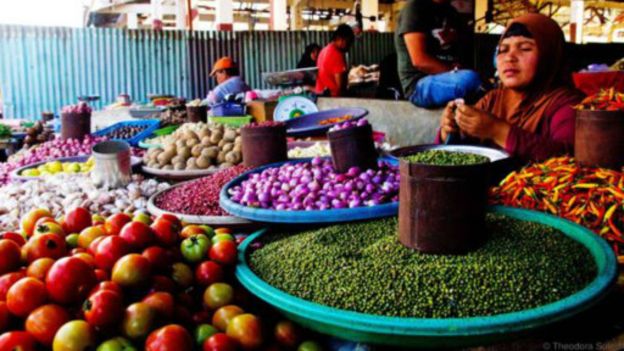
托莫洪市场还出售更多普通的烹饪食料(图片来源:Theodora Sutcliffe)
来自巴厘岛和阿姆斯特丹的大厨正在探寻woku的魔力,woku是一种味道浓郁的酱汁,是用青柠、柠檬叶、柠檬草、葱和柠檬罗勒制作成的。这种酱料用于烹调鱼和鸡肉。配上柠檬叶、柠檬草、柠檬罗勒以及辣椒的rica-rica,味道非常鲜美,整个印度尼西亚群岛都可以吃得到,但有些地方调料不同。
当然,在印度尼西亚专门的狗肉餐馆里——这样的餐馆被冠上简称为“RW”——我们总是能在菜单里找到米纳哈萨的料理。
(责编:友义)
Indonesia's best – and goriest – cuisine
By Theodora Sutcliffe,8 May 2024
The dog's singed carcass lay rigid – jaws locked open, muzzle high, all four legs protruding skywards. Across the market, a butcher bisected another canine corpse, beheaded it and jointed it for sale. Below the table holding the dead body, live cats slunk and mewled, while dogs so scrawny as to be bereft of nutritional value lay curled in a hopeless doze.
It was a typically Saturday morning in the Minahasa meat section of Indonesia’s busy Tomohon Market, located in the volcanic highlands of North Sulawesi. Bats, neatly separated from their wings, gaped in a silent, toothy scream; a python spilled its strangely pallid guts; bush rats impaled on sticks lay piled up like kebabs. An iron-heavy, slightly faecal smell filled the air. Dressed in jeans and T-shirts, football shorts and fake Lacoste, blouses, the shoppers looked indistinguishable from any other Indonesian market crowd. But almost all were Minahasa people, famous for their bizarre – yet delicious – cuisine.
Although they left the forest centuries ago, Minahasa people still eat many of the same meats that their highland forerunners did 6,000 years earlier, including wild boar, snake and bat. “At Easter, there will be monkeys and turtles in the market,” said expedition leader Michael Leitzinger, who runs the nearby Mountain View Resort & Spa. “They eat them for a treat just as we might have turkey for Christmas.”
Today's Minahasa people are overwhelmingly Christian. During the 19th Century, the Dutch colonial government worked to eliminate all forms of Minahasa ritual, from headhunting and sacrifice to multi-family houses and sarcophagus burials. Protestant missionaries pushed Christian doctrine so effectively that in 1857, 10,000 Minahasa converted in a single day.
Even with the conversion, though, statues of tonaas – historic leaders with magical powers – are as common as churches in the town of Tomohon. And in the Woloan district just outside of town, cigarettes and cups of cap tikus, a local moonshine distilled from palm sap, rest below a sacred tree near the ruins of an ancient stone sarcophagus. They are offerings to the ancestral spirit that inhabits it.
Blood magic has been banned from the sacred megalith of Watu Pinawetengan on the slopes of the nearby Soputan volcano, apparently because the caretaker objected to cleaning up the gore. But Minahasa black magicians still make animal sacrifices at a secret cave each full moon.
“It's usually a white chicken for white magic, but can be black or white for other types of magic,” explained Veronica, a local magician.
Veronica is Catholic, and like almost all Minahasa, has a Christian name, but she sees no contradiction between her faith and her magic practice, believing that saints are just another name for spirits. For her, both magic and the habit of eating ancient forest foods are signs of an unusually resilient culture. “Minahasa culture is a very strong culture,” she said. “No matter how modern the world is, they will stick to the old ways.”
>And, indeed, strict rules govern the Minahasa menu. “We don't eat dogs from our hometown,” said Adam Pongoh, my Minahasa guide. As such, the dog catchers who round up animals from other towns at night are widely resented elsewhere in Indonesia.
When Pongoh's father, Junus, started selling spices at the Tomohon Market more than 35 years ago, both the endangered tarsier (a tiny, bug-eyed primate) and the endangered kuskus (a nocturnal marsupial that's unique to the Sulawesi region) were regularly on sale. Following a government clampdown a few years back, it's mercifully hard to find threatened species nowadays.
Most exotic meats in the Tomohon Market are delicacies to be cooked at home as a special treat rather than served in restaurants. Python, Pongoh said, was becoming increasingly rare: “It tastes like chicken, and we use the same spices, but chicken is half the price.”
I had previously tried dog, cooked Minahasa style with galangal, chilli, garlic, shallots and more, and found it delicious – but very hard to eat. (Traditional Minahasa cooking has little regard for bones, and I personally found it challenging to scrape dog meat off the bone with my teeth.) So when Pongoh brought me to the Puncak EG restaurant (Jalan Dosen, Kuranga village, Tomohon), I was relieved to find that dog was already finished for the day. Bat, however, was not. Chopped into tiny chunks, complete with fatty, rubbery black skin, it looked astonishingly unappetising. But the combination of gamey meat and pine-scented, tangy coconut curry was highly palatable.
Python, later, was cooked in a delicious rica-rica sauce, heavy with chilli and lemon basil. The meat tasted fine – indeed, not far from chicken breast – but had too many small bones, while the patterned, slightly fatty skin was well outside my comfort zone.
Indeed, while it's the unusual ingredients that make Minahasa food notorious, it's the spice pastes, made from recipes handed down the generations, which have built its reputation. All Minahasa sauces start from a basic spice paste: chilli, salt, garlic, ginger, turmeric and candlenuts, pounded with an ultra-long pestle. Some, like the delicious babi daun leilem (pork with leilem leaves) gain their unique flavour from leaves only found in the Minahasa region, where plants are so atypical that Tomohon University has an herbal medicine department researching traditional uses. But others can and have travelled.
Chefs from Bali to Amsterdam are discovering the magic of woku, a tangy sauce with lime, kaffir lime leaves, lemongrass, spring onions and lemon basil, used for fish and chicken. Rica-rica, with kaffir lime leaves, lemongrass, lemon basil and lashings of chilli, is so delicious that it has spread, albeit often missing key ingredients, across the Indonesian archipelago.
And, of course, at Indonesia's specialist dog-meat eateries – identified by the euphemism “RW” - there will always be a Minahasa dish on the menu.